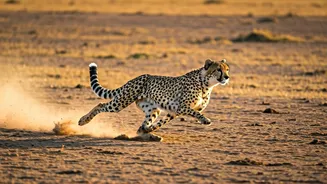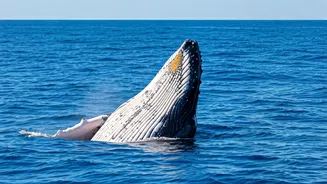Cheetah: Land's Lightning
The cheetah, renowned for its unparalleled land speed, tops the list of the fastest animals. These magnificent felines can reach speeds up to 75 mph (120
km/h) in short bursts, a remarkable feat facilitated by their slender bodies, flexible spines, and specialized paws. Cheetahs utilize their speed to hunt down prey in open grasslands, requiring them to accelerate and decelerate rapidly. Their spotted coat provides camouflage, further assisting in their hunting success. This exceptional speed allows them to catch fleet-footed animals like gazelles, ensuring their survival. The cheetah's adaptations make it a marvel of natural engineering, perfectly designed for speed and agility.
Peregrine Falcon's Dive
The peregrine falcon holds the record as the fastest animal in a dive, capable of reaching speeds exceeding 200 mph (320 km/h). This remarkable ability is due to their streamlined body shape and specialized feathers that minimize air resistance. During a dive, or stoop, the falcon folds its wings and plummets towards its prey, utilizing gravity to achieve incredible velocities. This hunting technique allows them to target birds in mid-air with unparalleled precision. Their keen eyesight further enhances their hunting efficiency, enabling them to spot prey from great distances. The peregrine falcon's aerial prowess showcases the efficiency of natural selection in creating speed and hunting mastery.
Sailfish's Aquatic Speed
The sailfish dominates the underwater realm, often reaching speeds up to 68 mph (110 km/h). Their unique dorsal fin, resembling a sail, helps in stability and maneuvering in the water. Sailfish are equipped with a hydrodynamic body that reduces water resistance, allowing them to swim quickly. They employ their speed to pursue smaller fish, making them effective predators in the ocean. This speed also contributes to escaping larger predators and moving to different feeding grounds. The sailfish's speed and agility demonstrate how aquatic animals have adapted to thrive in their environment.
Pronghorn: American Speedster
Native to North America, the pronghorn is often recognized as the second-fastest land animal, capable of reaching speeds up to 55 mph (88 km/h). Their physical attributes, like long legs and a light build, contribute to their sprinting capabilities. These animals have a unique respiratory system, which helps them take in more oxygen and sustain their speed over long distances. They use this speed to escape predators such as wolves and coyotes, particularly in the open plains where they live. The pronghorn's speed has made them a successful species, demonstrating their effectiveness in evading threats and surviving in their habitat.
Black Marlin's Ocean Dash
The black marlin is an exceptional swimmer, recorded at speeds up to 80 mph (129 km/h) in short bursts. Its streamlined body and powerful tail contribute significantly to its propulsion through the water. Black marlins are known for their leaping abilities, which they use to capture prey and to evade predators. They are formidable hunters, targeting other fish and squid in the vast ocean. Their speed is essential for their foraging and survival, allowing them to hunt effectively and navigate through their underwater environment. The black marlin’s adaptations make it a remarkable predator.
Greyhound's Rapid Pace
The greyhound, bred for speed, can attain speeds up to 45 mph (72 km/h). Their lean physique, deep chest, and strong legs are optimized for sprinting. These dogs have been selectively bred for racing, showcasing the power of genetics and human intervention in enhancing speed. The greyhound's agility and speed enable them to compete effectively in races. This breed’s history and continued relevance in the sporting world highlight the impact of speed on competitive outcomes.
Spine-tailed Swift's Flight
The spine-tailed swift is considered one of the fastest birds in horizontal flight, often reaching speeds up to 105 mph (169 km/h). Their aerodynamic build and pointed wings enable them to cut through the air with minimal resistance. They spend most of their lives in the air, feeding, drinking, and even sleeping while in flight. This extraordinary ability to travel at high speeds allows them to cover vast distances and catch insects effectively. Their aerial agility underscores the diversity of speed strategies in the animal kingdom, and highlights unique adaptations for survival.




